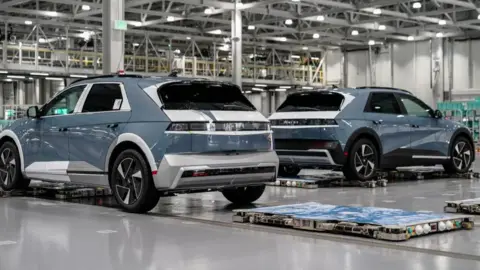KENT, Conn. (AP) — For most Americans, there’s less reason than ever to worry about finding chargers to fuel up an electric vehicle. But charging worries remain a top hesitation for potential buyers, second only to sticker shock.
Those concerns linger even as fast chargers multiply. More than 12,000 have been added within a mile of U.S. highways and interstates just this year, an Associated Press analysis of data from the National Renewable Energy Laboratory shows. That’s about a fifth of quick-charging ports now in operation.
Yet a new poll from The Associated Press-NORC Center for Public Affairs Research and the Energy Policy Institute at the University of Chicago finds about 4 in 10 of U.S. adults still point to range and charging time as “major” reasons they wouldn’t buy an EV. That’s significant considering only about 2 in 10 Americans say they would be “extremely” or “very” likely to make a new or used electric vehicle their next car purchase.
That’s a perception Daphne Dixon, leader of a nonprofit that advocates for clean transportation, has been trying to fight. She has taken a coast-to-coast road trip in an EV each year since 2022. Always sporting hot pink and waving a bubblegum checkered race flag to match, Dixon posts snapshots of the charging experience along her 3,000-mile (4,828-kilometer) route, hoping to 'bust' Americans’ anxiety about range and charging.
Dixon said she has repeatedly found that “range anxiety is stuck in people’s heads,” even though the gap in price between gas and electric cars is closing and more chargers are being installed.
“A lot of people still fear that there’s not enough chargers, but what they’re not seeing is that chargers are being put in every single day,” she said.
Traveling on Interstate 80, the longest American interstate, a driver will encounter few stretches that are more than 10 miles (16 kilometers) away from a fast charger, all the way from New York City to Des Moines. Out West, coverage is spottier. But the miles on I-80 covered by fast chargers has increased by 44% since 2021, the AP analysis found.
Drivers would have a similar experience on other major roads. Nearly 70% of the combined length of the 10 longest interstates is within 10 miles of a fast charger — up from about half just five years ago.
Installing fast chargers is considered critical to supporting EV adoption because they can refill a fully electric vehicle in 20 minutes to an hour. Compare that to home chargers, which often take four to 10 hours.
In Dixon’s home state of Connecticut, drivers still fret about charging. In the fall, Dixon takes a shorter trip along Route 7, a scenic drive full of river bends and antiques barns. Fast chargers are scarce along the route, as they still are in many rural parts of the U.S.
The only plug in Kent, a town about 50 miles (80 kilometers) north of Norwalk, is an aging machine at town hall that’s long been defunct, said Lynn Mellis Worthington, chair of the town’s sustainability team.
Connecticut’s state government plans to use $1.3 million in federal funds to install eight fast-charging plugs at two stations in New Milford, about 15 miles (24 kilometers) down Route 7 from Kent. The Trump administration sought to cancel those federal funds earlier this year, before reinstating them in August after multiple states sued over the halt of the $5 billion program. Congress had approved the funds in 2021 under the Bipartisan Infrastructure Law.
While many are concerned about charging, price is still the reason U.S. adults most commonly gave when asked why they would not buy one, the AP-NORC/EPIC poll shows. Only about 2 in 10 U.S. adults said the high cost is “not a reason” for holding off on an EV purchase.
Electric vehicles held about 8% of the U.S. market share in 2024, up from 1.9% five years prior, according to data from Atlas Public Policy.
In the long run, owning an EV may be cheaper due to lower maintenance costs and the lower price of electricity compared to fuel in many places, said Daniel Wilkins, a policy analyst at Atlas Public Policy.
Still, “everyday Americans are focused more on the sticker price upfront,” he said.
Despite the expansion of charging networks and policies supporting EV adoption, it appears many Americans still carry reservations, illustrating the need for continued advocacy and education surrounding electric vehicle use and infrastructure.























